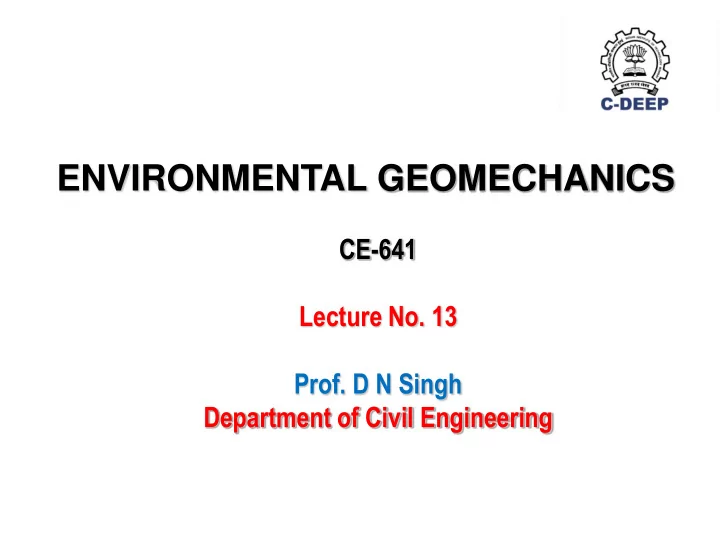

ENVIRONMENTAL GEOMECHANICS CE-641 Lecture No. 13 Prof. D N Singh Department of Civil Engineering
23.09.2019 Lecture No. 13 Lecture Name: Geomaterial Characterization Sub-topics • Chemical characterization Pore-solution sampling Corrosion potential Sorption-Desorption • Thermal Characterization • Electrical Characterization • Magnetic Characterization
Pore-solution Sampling The pore-solution sampling is identical to blood sampling A Prerequisite to Soil-Water-Contaminant Interaction Studies To predict transport/fate of contaminants in the soil mass Design of suitable containment/Barrier system Assessment of safe waste disposal limits: Quantity & Concentration Leaching/Attenuation characteristics of soils Intrusion of pollutants in ground water resources Prediction of the loss of nutrients from the root zone Detection of the microbial activity in soils Validation of solute transport models
Sampling Techniques In-situ (Field) • Lysimeter Zero-tension Lysimeter Tension Lysimeter • Soil Salinity Sensors • Absorption Techniques Laboratory • Centrifugation • Pressure-membrane extractor (PME)
Lysimeter ( Pore Solution Collection Device) Zero Tension Lysimeter Collects Pore Solution From Saturated Soils Percolating water Control volume Soil Pervious fill Collection device to Collection bottle
Field Lysimeter To collect leachate 485 mm Percolating water Waste rock material 40 mm thick creek sand 50 mm thick Gravel (5-7 mm) 300 mm thick Gravel (14mm) Gravel (5-7 mm) Occurrence of preferential flow Influence of mobile colloids on contaminant mobility Extra organic matter in soil reduced colloid release
Zero-tension Lysimeter Loose fill O A Undisturbed soil core Sand Sloping bottom A : Air inlet O : Pore solution extraction
Collection Basin Lysimeter Clay liner Granular Backfill P Flexible membrane liner P : Perforated pipe To detect leakage from the clay liner To determine in situ hydraulic conductivity of the liners To demonstrate proper functioning of the clay liner
Basic Philosophy Rain water Upper compartment with fill material, sensors and moisture extraction cups Lower compartment for leachate collection Leachate Performance assessment of solidified radioactive waste Attenuation properties of soils Validation of theoretical model by fitting Mathematical model to Lysimeter data
Tension Lysimeter Collects pore- solution from “Unsaturated Soils” To sample bottle To Vacuum pump Ground PVC pipe I – Inflow of pore solution Porous ceramic cup under vacuum applied I I
Importance of Lysimetric studies Lysimeter Device which creates a control volume of soil for studying various contaminant transport mechanisms under in-situ conditions Field studies No control of boundary conditions, cost and time intensive Laboratory studies Cannot simulate field conditions, Spatial variability cannot be taken into account Lysimetric study Intermittent approach Simulates In-situ conditions with better control on boundary conditions Lysimeter identified as a potential tool for studying radioactive contaminant Interaction and migration in Geoenvironment
R is the soil spiked (with Cs, Co & Tritium)
Slurry of native soil
Vial for pore-solution collection
To the Flexible rubber tube vacuum Pump Stopper Screw cap Sample Collector Perspex tube Soil slurry Ceramic thimble Details of the suction sampler
Activities at a Glance
TDR studies 0 15/06/05 20/06/05 05/07/05 14/07/05 18/07/05 20 26/7 flash floods 26/08/05 27/09/05 40 GSL 60 80 Depth(cm) 100 120 140 160 180 200 0.0 0.1 0.2 0.3 0.4 0.5 Hanumantha Rao, B, Sridhar, V., Rakesh, R.R., Singh, D.N. , Narayan, P.K. and Wattal, P.K., “Application of In -situ Lysimetric Studies for Determining Soil Hydraulic Conductivity”, Geotechnical and Geological Engineering, 2009 , DOI 10.1007/ s10706-009-9260-5. Published Online: 13 May 2009.
Variation of 137 Cs and 60 Co activity concentration with depth in dry soils after a period of 500 days
Pressure Membrane Extractor S PG PG P RU PME A B C R Air inlet Pressure gauge Air pressure Drain Expelled water to the sampling bottle
Recommend
More recommend